Growth Simulations of Urban Underground Space with Ecological Constraints Using a Patch-Based Cellular Automaton
Abstract
:1. Introduction
- To prioritize the importance of ecological conservation zoning in the future development of UUS use, the AgentLA model was used for ecological conservation zones (urban BGS protection areas) as a spatial constraint in the UUS growth simulation;
- A method based on the RF algorithm to determine the spatial drivers of UUS growth simulation was constructed based on the process and underlying mechanism of UUS development and the spatial driving factors considered in previous urban simulation studies;
- A method was constructed to simulate UUS growth based on the patch-CA model, in which the three spatial pattern types of UUS growth (filling, edge extension, and outlying) were simulated using two complementary procedures of organic and spontaneous growth in the proposed patch-CA model;
- UUS growth simulations under ecological constraints are evaluated using the Tianfu New District in Chengdu, China, as an example, and the validity and reproducibility of the model proposed in this study are verified.
2. Literature Review
2.1. Simulation Model of UUS Growth
| Number | Researcher(s) | Year(s) | Model(s) | Field of Study | Case Study |
|---|---|---|---|---|---|
| 1 | Mitsova et al. [44] | 2011 | CA-Markov chain model | Urban growth projections at a regional scale | Twenty-seven counties in Ohio, Indiana, and Kentucky, USA |
| 2 | Sakieh et al. [34] | 2014 | CA model | Simulating urban expansion and scenario prediction | Karaj City, Iran |
| 3 | Deep et al. [43] | 2014 | CA-Markov chain model | Measure the urban sprawl | Dehradun City, India |
| 4 | Guan et al. [35] | 2015 | Hybrid parallel CA model | Urban growth simulation | California, USA |
| 5 | Liao et al. [36] | 2015 | Logistic-CA model | Land-use simulations | Xiamen City, China |
| 6 | Dahal et al. [42] | 2015 | An irregular CA model | Urban land-use dynamics | San Marcos, Texas, USA |
| 7 | Gounaridis et al. [37] | 2019 | Random Forest—CA model | Explore future land use/cover change | Attica, Greece |
| 8 | Liao et al. [56] | 2019 | Logistic regression-ordered weighted averaging-CA model | Urban sprawl scenario simulations | Xiamen City, China |
| 9 | Shu et al. [38] | 2020 | Traditional logistic CA model | Simulate the urban growth | Tongshan County, China |
| 10 | Chen et al. [39] | 2020 | Geographically weighted regression—CA model | Simulate the urban expansion | Chongqing City, China |
| 11 | Roodposhti et al. [45] | 2020 | CA land-use models | Land-use change (LUC) | Ahvaz, Iran |
| 12 | Cao et al. [55] | 2020 | Logistic-CA model | Urban spatial growth | Hangzhou City, China |
| 13 | Zhou et al. [58] | 2020 | Random Forest and CA-Markov model | Multi-scenario simulation of urban land change | Shanghai City, China |
| 14 | Dinda et al. [40] | 2021 | CA-Markov Chain model | Urban growth pattern and loss in urban green space | Kolkata, India |
| 15 | Wang et al. [59] | 2021 | SM-Logistic-CA model | Simulating urban land growth | Beijing City, China |
| 16 | Liang et al. [62] | 2021 | Patch-generating land-use simulation model | Drivers of land expansion and landscape dynamics | Wuhan City, China |
| 17 | Liu et al. [41] | 2022 | ESP-FLUS Model | Urban growth boundaries | Min Delta Region, China |
| 18 | Jin et al. [57] | 2023 | CA-based Future Land Use Simulation (FLUS) model | Land-use change (LUC) | Myanmar |
| 19 | Lin et al. [63] | 2023 | Novel landscape-driven patch-based CA model | Urban land-use changes | Guangzhou City, China |
2.2. UUS Growth Constraint Mechanisms
3. Methodology
3.1. Generating UUS Development Constraints
3.2. Basic Simulations of the CA Model for UUS Growth
3.3. Simulating UUS Growth Using the Patch-Based CA Model
- Suitability-based sorting: The patch growth algorithm ranks the suitability of all cells according to Equation (10). The corresponding subset of cells with the highest suitability is retained according to the expected area of UUS, and the cells with very low suitability are excluded.
- Stochastic seeding: Stochastic seeding is performed on a subset of the retained cells of UUS. A stochastically selected cell is tested for stochastic seeding; the selected cell is used as the seed cell if its suitability is greater than a random number uniformly distributed in the interval of [0, 1], and the cell is accepted as a seed to start a new patch. Otherwise, the stochastic seeding test continues to iterate until a seed cell appears. For the two complementary growth procedures of UUS, we treat the seed cells connected to the built-up area as organically grown cells and the seed cells not connected to it as spontaneously grown cells.
- Moving-window scanning process: A 3 × 3 cell is chosen as the scanning window size, with the seed cell as the center and the other cells within the window as candidates for the self-growing of new patches. The candidate cells determine the next seed cell according to the stochastic seeding principle, while the previous seed cell transforms into a newly grown patch. Then, the scanning window is moved to the center of the new seed cell and continues stochastic seeding within the window to grow patches until the area reaches the expected area of UUS and the self-growing of patches ends. Notably, when the scanning window moves to the new seed cell while the candidate cells are already within the window, then the patch growth is made more compact by multiplying the isometric parameter in the interval of [0, 2] to narrow or amplify its adaptation.
3.4. Validation of Model Accuracy
4. Information and Data of the Study Area
4.1. Study Area
4.2. Experimental Data
- Data on urban planning land, such as study area boundaries, the area of building land and its spatial distribution, and land-use types and their spatial distribution;
- Data on UUS planning, such as the area and spatial distribution of UUS development and the visionary planning situation of UUS;
- Geographic information-related data, such as slope, elevation, aspect, average rainfall, and average temperature data;
- Transportation-related data information, such as the spatial distribution of subway stations and lines, the location of train stations, the spatial distribution of highway lines, and the spatial layout of city roads.
5. Implementations and Results
5.1. Setting of Model Parameters
5.2. Results of UUS Growth Simulation
6. Discussion and Analysis
6.1. Unconstrained by Ecological Constraints of UUS Growth Simulation
6.2. Constrained by Ecological Constraints of UUS Growth Simulation
6.3. Comparative Analysis with or without Ecological Constraints
7. Conclusions
Author Contributions
Funding
Data Availability Statement
Acknowledgments
Conflicts of Interest
References
- Teoh, R.; Anciaes, P.; Jones, P. Urban Mobility Transitions through GDP Growth: Policy Choices Facing Cities in Developing Countries. J. Transp. Geogr. 2020, 88, 102832. [Google Scholar] [CrossRef]
- Jedwab, R.; Loungani, P.; Yezer, A. Comparing Cities in Developed and Developing Countries: Population, Land Area, Building Height and Crowding. Reg. Sci. Urban Econ. 2021, 86, 103609. [Google Scholar] [CrossRef]
- Wolsink, M. ‘Sustainable City’ Requires ‘Recognition’—The Example of Environmental Education under Pressure from the Compact City. Land Use Policy 2016, 52, 174–180. [Google Scholar] [CrossRef]
- Bibri, S.E.; Krogstie, J.; Kärrholm, M. Compact City Planning and Development: Emerging Practices and Strategies for Achieving the Goals of Sustainability. Dev. Built Environ. 2020, 4, 100021. [Google Scholar] [CrossRef]
- Bobylev, N. Mainstreaming Sustainable Development into a City’s Master Plan: A Case of Urban Underground Space Use. Land Use Policy 2009, 26, 1128–1137. [Google Scholar] [CrossRef]
- Bobylev, N.; Sterling, R. Urban Underground Space: A Growing Imperative. Tunn. Undergr. Space Technol. 2016, 55, 1–4. [Google Scholar] [CrossRef]
- Lin, D.; Broere, W.; Cui, J. Underground Space Utilisation and New Town Development: Experiences, Lessons and Implications. Tunn. Undergr. Space Technol. 2022, 119, 104204. [Google Scholar] [CrossRef]
- Qiao, Y.-K.; Peng, F.-L.; Sabri, S.; Rajabifard, A. Low Carbon Effects of Urban Underground Space. Sustain. Cities Soc. 2019, 45, 451–459. [Google Scholar] [CrossRef]
- Xia, H.; Lin, C.; Liu, X.; Liu, Z. Urban Underground Space Capacity Demand Forecasting Based on Sustainable Concept: A Review. Energy Build. 2022, 255, 111656. [Google Scholar] [CrossRef]
- Bobylev, N.; Syrbe, R.-U.; Wende, W. Geosystem Services in Urban Planning. Sustain. Cities Soc. 2022, 85, 104041. [Google Scholar] [CrossRef]
- Hunt, D.V.L.; Makana, L.O.; Jefferson, I.; Rogers, C.D.F. Liveable Cities and Urban Underground Space. Tunn. Undergr. Space Technol. 2016, 55, 8–20. [Google Scholar] [CrossRef]
- Qiao, Y.-K.; Peng, F.-L.; Wu, X.-L.; Luan, Y.-P. Visualization and Spatial Analysis of Socio-Environmental Externalities of Urban Underground Space Use: Part 1 Positive Externalities. Tunn. Undergr. Space Technol. 2022, 121, 104325. [Google Scholar] [CrossRef]
- Zhang, Y.; Zhu, J.; Liao, Z.; Guo, J.; Xie, H.; Peng, Q. An Intelligent Planning Model for the Development and Utilization of Urban Underground Space with an Application to the Luohu District in Shenzhen. Tunn. Undergr. Space Technol. 2021, 112, 103933. [Google Scholar] [CrossRef]
- Zhang, C.; Zhao, Z.; Guo, D.; Gong, D.; Chen, Y. Optimization of Spatial Layouts for Deep Underground Infrastructure in Central Business Districts Based on a Multi-Agent System Model. Tunn. Undergr. Space Technol. 2023, 135, 105046. [Google Scholar] [CrossRef]
- Bobylev, N. Underground Space as an Urban Indicator: Measuring Use of Subsurface. Tunn. Undergr. Space Technol. 2016, 55, 40–51. [Google Scholar] [CrossRef]
- Chen, Y.; Chen, Z.; Guo, D.; Zhao, Z. Simulating Spatiotemporal Dynamics of Urban Underground Space Development Using Multi-Agent System: A Case Study in Changzhou City, China. Tunn. Undergr. Space Technol. 2022, 124, 104482. [Google Scholar] [CrossRef]
- Cui, J.; Broere, W.; Lin, D. Underground Space Utilisation for Urban Renewal. Tunn. Undergr. Space Technol. 2021, 108, 103726. [Google Scholar] [CrossRef]
- Zhao, J.-W.; Peng, F.-L.; Wang, T.-Q.; Zhang, X.-Y.; Jiang, B.-N. Advances in Master Planning of Urban Underground Space (UUS) in China. Tunn. Undergr. Space Technol. 2016, 55, 290–307. [Google Scholar] [CrossRef]
- Volchko, Y.; Norrman, J.; Ericsson, L.O.; Nilsson, K.L.; Markstedt, A.; Öberg, M.; Mossmark, F.; Bobylev, N.; Tengborg, P. Subsurface Planning: Towards a Common Understanding of the Subsurface as a Multifunctional Resource. Land Use Policy 2020, 90, 104316. [Google Scholar] [CrossRef]
- Zhao, P.; Li, X.; Zhang, W.; Xiong, Z.; Xu, W.; Dai, J.; Deng, L. System Dynamics: A New Approach for the Evaluation of Urban Underground Resource Integrated Development. Tunn. Undergr. Space Technol. 2022, 119, 104213. [Google Scholar] [CrossRef]
- Price, S.J.; Terrington, R.L.; Busby, J.; Bricker, S.; Berry, T. 3D Ground-Use Optimisation for Sustainable Urban Development Planning: A Case-Study from Earls Court, London, UK. Tunn. Undergr. Space Technol. 2018, 81, 144–164. [Google Scholar] [CrossRef]
- Broere, W. Urban Underground Space: Solving the Problems of Today’s Cities. Tunn. Undergr. Space Technol. 2016, 55, 245–248. [Google Scholar] [CrossRef]
- Qiao, Y.K.; Peng, F.L. Lessons Learnt from Urban Underground Space Use in Shanghai—From Lujiazui Business District to Hongqiao Central Business District. Tunn. Undergr. Space Technol. 2016, 55, 308–319. [Google Scholar] [CrossRef]
- Li, X.; Li, C.; Parriaux, A.; Wu, W.; Li, H.; Sun, L.; Liu, C. Multiple Resources and Their Sustainable Development in Urban Underground Space. Tunn. Undergr. Space Technol. 2016, 55, 59–66. [Google Scholar] [CrossRef]
- Peng, F.-L.; Qiao, Y.-K.; Sabri, S.; Atazadeh, B.; Rajabifard, A. A Collaborative Approach for Urban Underground Space Development toward Sustainable Development Goals: Critical Dimensions and Future Directions. Front. Struct. Civ. Eng. 2021, 15, 20–45. [Google Scholar] [CrossRef]
- Li, X.; Xu, H.; Li, C.; Sun, L.; Wang, R. Study on the Demand and Driving Factors of Urban Underground Space Use. Tunn. Undergr. Space Technol. 2016, 55, 52–58. [Google Scholar] [CrossRef]
- Peng, J.; Peng, F.-L. A GIS-Based Evaluation Method of Underground Space Resources for Urban Spatial Planning: Part 1 Methodology. Tunn. Undergr. Space Technol. 2018, 74, 82–95. [Google Scholar] [CrossRef]
- von der Tann, L.; Ritter, S.; Hale, S.; Langford, J.; Salazar, S. From Urban Underground Space (UUS) to Sustainable Underground Urbanism (SUU): Shifting the Focus in Urban Underground Scholarship. Land Use Policy 2021, 109, 105650. [Google Scholar] [CrossRef]
- Darroch, N.; Beecroft, M.; Nelson, J.D. Going Underground: An Exploration of the Interfaces between Underground Urban Transport Infrastructure and Its Environment. Tunn. Undergr. Space Technol. 2018, 81, 450–462. [Google Scholar] [CrossRef]
- Xu, Y.; Chen, X. Quantitative Analysis of Spatial Vitality and Spatial Characteristics of Urban Underground Space (UUS) in Metro Area. Tunn. Undergr. Space Technol. 2021, 111, 103875. [Google Scholar] [CrossRef]
- Wei, L.; Guo, D.; Chen, Z.; Yang, J.; Feng, T. Forecasting Short-Term Passenger Flow of Subway Stations Based on the Temporal Pattern Attention Mechanism and the Long Short-Term Memory Network. ISPRS Int. J. Geo-Inf. 2023, 12, 25. [Google Scholar] [CrossRef]
- Li, H.; Wan, B.; Chu, D.; Wang, R.; Ma, G.; Fu, J.; Xiao, Z. Progressive Geological Modeling and Uncertainty Analysis Using Machine Learning. ISPRS Int. J. Geo-Inf. 2023, 12, 97. [Google Scholar] [CrossRef]
- Peng, Z.; Zhang, Y.; Tan, F.; Lv, J.; Li, L. Variable-Weight Suitability Evaluation of Underground Space Development Considering Socioeconomic Factors. Sustainability 2023, 15, 3574. [Google Scholar] [CrossRef]
- Sakieh, Y.; Amiri, B.J.; Danekar, A.; Feghhi, J.; Dezhkam, S. Simulating Urban Expansion and Scenario Prediction Using a Cellular Automata Urban Growth Model, SLEUTH, through a Case Study of Karaj City, Iran. J. Hous. Built Environ. 2015, 30, 591–611. [Google Scholar] [CrossRef]
- Guan, Q.; Shi, X.; Huang, M.; Lai, C. A Hybrid Parallel Cellular Automata Model for Urban Growth Simulation over GPU/CPU Heterogeneous Architectures. Int. J. Geogr. Inf. Sci. 2016, 30, 494–514. [Google Scholar] [CrossRef]
- Liao, J.; Tang, L.; Shao, G.; Su, X.; Chen, D.; Xu, T. Incorporation of Extended Neighborhood Mechanisms and Its Impact on Urban Land-Use Cellular Automata Simulations. Environ. Model. Softw. 2016, 75, 163–175. [Google Scholar] [CrossRef]
- Gounaridis, D.; Chorianopoulos, I.; Symeonakis, E.; Koukoulas, S. A Random Forest-Cellular Automata Modelling Approach to Explore Future Land Use/Cover Change in Attica (Greece), under Different Socio-Economic Realities and Scales. Sci. Total Environ. 2019, 646, 320–335. [Google Scholar] [CrossRef]
- Shu, B.; Zhu, S.; Qu, Y.; Zhang, H.; Li, X.; Carsjens, G.J. Modelling Multi-Regional Urban Growth with Multilevel Logistic Cellular Automata. Comput. Environ. Urban Syst. 2020, 80, 101457. [Google Scholar] [CrossRef]
- Chen, S.; Feng, Y.; Tong, X.; Liu, S.; Xie, H.; Gao, C.; Lei, Z. Modeling ESV Losses Caused by Urban Expansion Using Cellular Automata and Geographically Weighted Regression. Sci. Total Environ. 2020, 712, 136509. [Google Scholar] [CrossRef]
- Dinda, S.; Das Chatterjee, N.; Ghosh, S. An Integrated Simulation Approach to the Assessment of Urban Growth Pattern and Loss in Urban Green Space in Kolkata, India: A GIS-Based Analysis. Ecol. Indic. 2021, 121, 107178. [Google Scholar] [CrossRef]
- Liu, X.; Wei, M.; Li, Z.; Zeng, J. Multi-Scenario Simulation of Urban Growth Boundaries with an ESP-FLUS Model: A Case Study of the Min Delta Region, China. Ecol. Indic. 2022, 135, 108538. [Google Scholar] [CrossRef]
- Dahal, K.R.; Chow, T.E. Characterization of Neighborhood Sensitivity of an Irregular Cellular Automata Model of Urban Growth. Int. J. Geogr. Inf. Sci. 2015, 29, 475–497. [Google Scholar] [CrossRef]
- Deep, S.; Saklani, A. Urban Sprawl Modeling Using Cellular Automata. Egypt. J. Remote Sens. Space Sci. 2014, 17, 179–187. [Google Scholar] [CrossRef]
- Mitsova, D.; Shuster, W.; Wang, X. A Cellular Automata Model of Land Cover Change to Integrate Urban Growth with Open Space Conservation. Landsc. Urban Plan. 2011, 99, 141–153. [Google Scholar] [CrossRef]
- Roodposhti, M.S.; Hewitt, R.J.; Bryan, B.A. Towards Automatic Calibration of Neighbourhood Influence in Cellular Automata Land-Use Models. Comput. Environ. Urban Syst. 2020, 79, 101416. [Google Scholar] [CrossRef]
- Yu, Z.; Yang, G.; Zuo, S.; Jørgensen, G.; Koga, M.; Vejre, H. Critical Review on the Cooling Effect of Urban Blue-Green Space: A Threshold-Size Perspective. Urban For. Urban Green. 2020, 49, 126630. [Google Scholar] [CrossRef]
- Song, S.; Wang, S.; Shi, M.; Hu, S.; Xu, D. Urban Blue–Green Space Landscape Ecological Health Assessment Based on the Integration of Pattern, Process, Function and Sustainability. Sci. Rep. 2022, 12, 7707. [Google Scholar] [CrossRef]
- Chen, Y.; Chen, Z.; Guo, D.; Zhao, Z.; Lin, T.; Zhang, C. Underground Space Use of Urban Built-up Areas in the Central City of Nanjing: Insight Based on a Dynamic Population Distribution. Undergr. Space 2022, 7, 748–766. [Google Scholar] [CrossRef]
- Bartel, S.; Janssen, G. Underground Spatial Planning—Perspectives and Current Research in Germany. Tunn. Undergr. Space Technol. 2016, 55, 112–117. [Google Scholar] [CrossRef]
- Edelenbos, J.; Monnikhof, R.; Haasnoot, J.; van der Hoeven, F.; Horvat, E.; van der Krogt, R. Strategic Study on the Utilization of Underground Space in the Netherlands. Tunn. Undergr. Space Technol. 1998, 13, 159–165. [Google Scholar] [CrossRef]
- Monnikhof, R.A.H.; Edelenbos, J.; van der Hoeven, F.; van der Krogt, R.A.A. The New Underground Planning Map of the Netherlands: A Feasibility Study of the Possibilities of the Use of Underground Space. Tunn. Undergr. Space Technol. 1999, 14, 341–347. [Google Scholar] [CrossRef]
- von der Tann, L.; Sterling, R.; Zhou, Y.; Metje, N. Systems Approaches to Urban Underground Space Planning and Management—A Review. Undergr. Space 2020, 5, 144–166. [Google Scholar] [CrossRef]
- Doyle, M.R. From Hydro/Geology to the Streetscape: Evaluating Urban Underground Resource Potential. Tunn. Undergr. Space Technol. 2016, 55, 83–95. [Google Scholar] [CrossRef]
- Xie, H.; Zhang, Y.; Chen, Y.; Peng, Q.; Liao, Z.; Zhu, J. A Case Study of Development and Utilization of Urban Underground Space in Shenzhen and the Guangdong-Hong Kong-Macao Greater Bay Area. Tunn. Undergr. Space Technol. 2021, 107, 103651. [Google Scholar] [CrossRef]
- Cao, Y.; Zhang, X.; Fu, Y.; Lu, Z.; Shen, X. Urban Spatial Growth Modeling Using Logistic Regression and Cellular Automata: A Case Study of Hangzhou. Ecol. Indic. 2020, 113, 106200. [Google Scholar] [CrossRef]
- Liao, J.; Shao, G.; Wang, C.; Tang, L.; Huang, Q.; Qiu, Q. Urban Sprawl Scenario Simulations Based on Cellular Automata and Ordered Weighted Averaging Ecological Constraints. Ecol. Indic. 2019, 107, 105572. [Google Scholar] [CrossRef]
- Jin, Y.; Li, A.; Bian, J.; Nan, X.; Lei, G. Modeling the Impact of Investment and National Planning Policies on Future Land Use Development: A Case Study for Myanmar. ISPRS Int. J. Geo-Inf. 2023, 12, 22. [Google Scholar] [CrossRef]
- Zhou, L.; Dang, X.; Sun, Q.; Wang, S. Multi-Scenario Simulation of Urban Land Change in Shanghai by Random Forest and CA-Markov Model. Sustain. Cities Soc. 2020, 55, 102045. [Google Scholar] [CrossRef]
- Wang, H.; Guo, J.; Zhang, B.; Zeng, H. Simulating Urban Land Growth by Incorporating Historical Information into a Cellular Automata Model. Landsc. Urban Plan. 2021, 214, 104168. [Google Scholar] [CrossRef]
- Yang, G.; Yu, Z.; Jørgensen, G.; Vejre, H. How Can Urban Blue-Green Space Be Planned for Climate Adaption in High-Latitude Cities? A Seasonal Perspective. Sustain. Cities Soc. 2020, 53, 101932. [Google Scholar] [CrossRef]
- Chen, Y.; Li, X.; Liu, X.; Ai, B. Modeling Urban Land-Use Dynamics in a Fast Developing City Using the Modified Logistic Cellular Automaton with a Patch-Based Simulation Strategy. Int. J. Geogr. Inf. Sci. 2013, 28, 234–255. [Google Scholar] [CrossRef]
- Liang, X.; Guan, Q.; Clarke, K.C.; Liu, S.; Wang, B.; Yao, Y. Understanding the Drivers of Sustainable Land Expansion Using a Patch-Generating Land Use Simulation (PLUS) Model: A Case Study in Wuhan, China. Comput. Environ. Urban Syst. 2021, 85, 101569. [Google Scholar] [CrossRef]
- Lin, J.; Li, X.; Wen, Y.; He, P. Modeling Urban Land-Use Changes Using a Landscape-Driven Patch-Based Cellular Automaton (LP-CA). Cities 2023, 132, 103906. [Google Scholar] [CrossRef]
- Dunn, A.G.; Majer, J.D. Simulating Weed Propagation Via Hierarchical, Patch-Based Cellular Automata. Lect. Notes Comput. Sci. 2007, 4487, 762–769. [Google Scholar] [CrossRef]
- Li, X.; Gong, P.; Yu, L.; Hu, T. A Segment Derived Patch-Based Logistic Cellular Automata for Urban Growth Modeling with Heuristic Rules. Comput. Environ. Urban Syst. 2017, 65, 140–149. [Google Scholar] [CrossRef]
- Kim, I.; Kwon, H. Assessing the Impacts of Urban Land Use Changes on Regional Ecosystem Services According to Urban Green Space Policies Via the Patch-Based Cellular Automata Model. Environ. Manag. 2020, 67, 192–204. [Google Scholar] [CrossRef]
- Wang, H.; Zhang, B.; Xia, C.; He, S.; Zhang, W. Using a Maximum Entropy Model to Optimize the Stochastic Component of Urban Cellular Automata Models. Int. J. Geogr. Inf. Sci. 2019, 34, 924–946. [Google Scholar] [CrossRef]
- Xia, C.; Zhang, B.; Wang, H.; Qiao, S.; Zhang, A. A Minimum-Volume Oriented Bounding Box Strategy for Improving the Performance of Urban Cellular Automata Based on Vectorization and Parallel Computing Technology. GISci. Remote Sens. 2019, 57, 91–106. [Google Scholar] [CrossRef]
- He, C.; Zhao, Y.; Tian, J.; Shi, P. Modeling the Urban Landscape Dynamics in a Megalopolitan Cluster Area by Incorporating a Gravitational Field Model with Cellular Automata. Landsc. Urban Plan. 2013, 113, 78–89. [Google Scholar] [CrossRef]
- Liu, D.; Zheng, X.; Wang, H. Land-Use Simulation and Decision-Support System (LandSDS): Seamlessly Integrating System Dynamics, Agent-Based Model, and Cellular Automata. Ecol. Model. 2020, 417, 108924. [Google Scholar] [CrossRef]
- Liu, J.; Xiao, B.; Li, Y.; Wang, X.; Bie, Q.; Jiao, J. Simulation of Dynamic Urban Expansion under Ecological Constraints Using a Long Short Term Memory Network Model and Cellular Automata. Remote Sens. 2021, 13, 1499. [Google Scholar] [CrossRef]
- Ma, Q. Integrating Ecological Correlation into Cellular Automata for Urban Growth Simulation: A Case Study of Hangzhou, China. Urban For. Urban Green. 2020, 51, 126697. [Google Scholar] [CrossRef]
- Sfa, F.E.; Nemiche, M.; Rayd, H. A Generic Macroscopic Cellular Automata Model for Land Use Change: The Case of the Drâa Valley. Ecol. Complex. 2020, 43, 100851. [Google Scholar] [CrossRef]
- Zhang, Y.; Chang, X.; Liu, Y.; Lu, Y.; Wang, Y.; Liu, Y. Urban Expansion Simulation under Constraint of Multiple Ecosystem Services (MESs) Based on Cellular Automata (CA)-Markov Model: Scenario Analysis and Policy Implications. Land Use Policy 2021, 108, 105667. [Google Scholar] [CrossRef]
- Ariluoma, M.; Ottelin, J.; Hautamäki, R.; Tuhkanen, E.-M.; Mänttäri, M. Carbon Sequestration and Storage Potential of Urban Green in Residential Yards: A Case Study from Helsinki. Urban For. Urban Green. 2021, 57, 126939. [Google Scholar] [CrossRef]
- Boukili, V.K.S.; Bebber, D.P.; Mortimer, T.; Venicx, G.; Lefcourt, D.; Chandler, M.; Eisenberg, C. Assessing the Performance of Urban Forest Carbon Sequestration Models Using Direct Measurements of Tree Growth. Urban For. Urban Green. 2017, 24, 212–221. [Google Scholar] [CrossRef]
- Uniyal, S.; Purohit, S.; Chaurasia, K.; Rao, S.S.; Amminedu, E. Quantification of Carbon Sequestration by Urban Forest Using Landsat 8 OLI and Machine Learning Algorithms in Jodhpur, India. Urban For. Urban Green. 2022, 67, 127445. [Google Scholar] [CrossRef]
- Sun, Y.; Xie, S.; Zhao, S. Valuing Urban Green Spaces in Mitigating Climate Change: A City-wide Estimate of Aboveground Carbon Stored in Urban Green Spaces of China’s Capital. Glob. Chang. Biol. 2019, 25, 1717–1732. [Google Scholar] [CrossRef]
- Yang, J.; Gong, J.; Tang, W.; Liu, C. Patch-Based Cellular Automata Model of Urban Growth Simulation: Integrating Feedback between Quantitative Composition and Spatial Configuration. Comput. Environ. Urban Syst. 2020, 79, 101402. [Google Scholar] [CrossRef]
- Labib, S.M.; Lindley, S.; Huck, J.J. Spatial Dimensions of the Influence of Urban Green-Blue Spaces on Human Health: A Systematic Review. Environ. Res. 2020, 180, 108869. [Google Scholar] [CrossRef]
- Shadman, S.; Ahanaf Khalid, P.; Hanafiah, M.M.; Koyande, A.K.; Islam, M.D.A.; Bhuiyan, S.A.; Sin Woon, K.; Show, P.-L. The Carbon Sequestration Potential of Urban Public Parks of Densely Populated Cities to Improve Environmental Sustainability. Sustain. Energy Technol. Assess. 2022, 52, 102064. [Google Scholar] [CrossRef]
- Chen, Y.; Li, X.; Liu, X.; Liu, Y. An Agent-Based Model for Optimal Land Allocation (AgentLA) with a Contiguity Constraint. Int. J. Geogr. Inf. Sci. 2010, 24, 1269–1288. [Google Scholar] [CrossRef]
- Chen, Y.; Li, X.; Liu, X.; Huang, H.; Ma, S. Simulating Urban Growth Boundaries Using a Patch-Based Cellular Automaton with Economic and Ecological Constraints. Int. J. Geogr. Inf. Sci. 2018, 33, 55–80. [Google Scholar] [CrossRef]
- Feng, Y.; Liu, Y.; Tong, X.; Liu, M.; Deng, S. Modeling Dynamic Urban Growth Using Cellular Automata and Particle Swarm Optimization Rules. Landsc. Urban Plan. 2011, 102, 188–196. [Google Scholar] [CrossRef]
- Cheng, J.; Masser, I. Understanding Spatial and Temporal Processes of Urban Growth: Cellular Automata Modelling. Environ. Plan. B Plan. Des. 2004, 31, 167–194. [Google Scholar] [CrossRef]
- Saganeiti, L.; Mustafa, A.; Teller, J.; Murgante, B. Modeling Urban Sprinkling with Cellular Automata. Sustain. Cities Soc. 2021, 65, 102586. [Google Scholar] [CrossRef]
- Yang, J.; Gong, J.; Tang, W.; Shen, Y.; Liu, C.; Gao, J. Delineation of Urban Growth Boundaries Using a Patch-Based Cellular Automata Model under Multiple Spatial and Socio-Economic Scenarios. Sustainability 2019, 11, 6159. [Google Scholar] [CrossRef]
- Zhang, D.; Liu, X.; Lin, Z.; Zhang, X.; Zhang, H. The Delineation of Urban Growth Boundaries in Complex Ecological Environment Areas by Using Cellular Automata and a Dual-Environmental Evaluation. J. Clean. Prod. 2020, 256, 120361. [Google Scholar] [CrossRef]
- Feng, Y.; Liu, Y.; Batty, M. Modeling Urban Growth with GIS Based Cellular Automata and Least Squares SVM Rules: A Case Study in Qingpu–Songjiang Area of Shanghai, China. Stoch. Environ. Res. Risk Assess. 2015, 30, 1387–1400. [Google Scholar] [CrossRef]
- Ma, S.; Jiang, H.; Zhang, X.; Xie, D.; Cai, Y.; Zhao, Y.; Wang, G. Quantify the Potential Spatial Reshaping Utility of Urban Growth Boundary (UGB): Evidence from the Constrained Scenario Simulation Model. ISPRS Int. J. Geo-Inf. 2022, 11, 511. [Google Scholar] [CrossRef]
- Kamusoko, C.; Gamba, J. Simulating Urban Growth Using a Random Forest-Cellular Automata (RF-CA) Model. ISPRS Int. J. Geo-Inf. 2015, 4, 447–470. [Google Scholar] [CrossRef]
- Liu, X.; Ma, L.; Li, X.; Ai, B.; Li, S.; He, Z. Simulating Urban Growth by Integrating Landscape Expansion Index (LEI) and Cellular Automata. Int. J. Geogr. Inf. Sci. 2013, 28, 148–163. [Google Scholar] [CrossRef]
- Xu, L.; Liu, X.; Tong, D.; Liu, Z.; Yin, L.; Zheng, W. Forecasting Urban Land Use Change Based on Cellular Automata and the PLUS Model. Land 2022, 11, 652. [Google Scholar] [CrossRef]
- Mustafa, A.; Cools, M.; Saadi, I.; Teller, J. Coupling Agent-Based, Cellular Automata and Logistic Regression into a Hybrid Urban Expansion Model (HUEM). Land Use Policy 2017, 69, 529–540. [Google Scholar] [CrossRef]
- Yang, X.; Bai, Y.; Che, L.; Qiao, F.; Xie, L. Incorporating Ecological Constraints into Urban Growth Boundaries: A Case Study of Ecologically Fragile Areas in the Upper Yellow River. Ecol. Indic. 2021, 124, 107436. [Google Scholar] [CrossRef]
- Pontius, R.G.; Boersma, W.; Castella, J.-C.; Clarke, K.; de Nijs, T.; Dietzel, C.; Duan, Z.; Fotsing, E.; Goldstein, N.; Kok, K.; et al. Comparing the Input, Output, and Validation Maps for Several Models of Land Change. Ann. Reg. Sci. 2007, 42, 11–37. [Google Scholar] [CrossRef]
- Gharaibeh, A.; Shaamala, A.; Obeidat, R.; Al-Kofahi, S. Improving Land-Use Change Modeling by Integrating ANN with Cellular Automata-Markov Chain Model. Heliyon 2020, 6, e05092. [Google Scholar] [CrossRef]
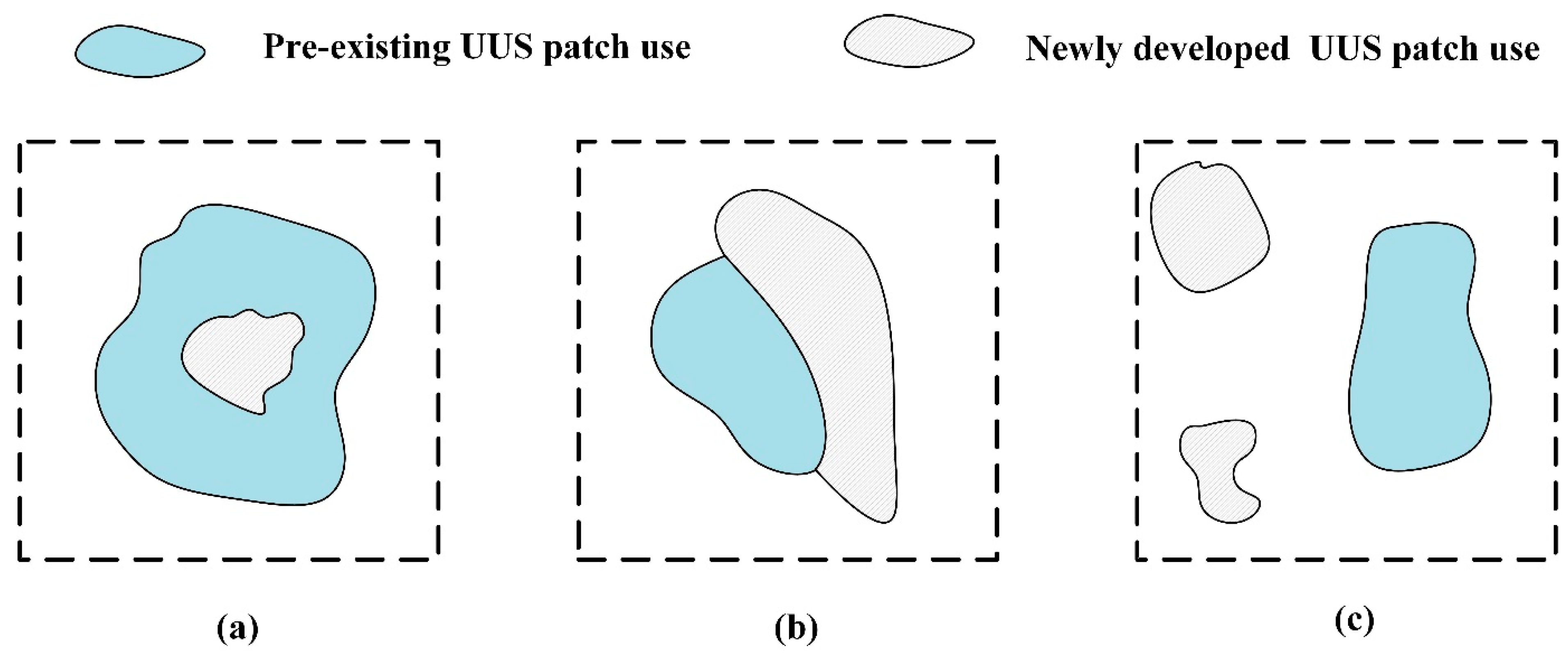

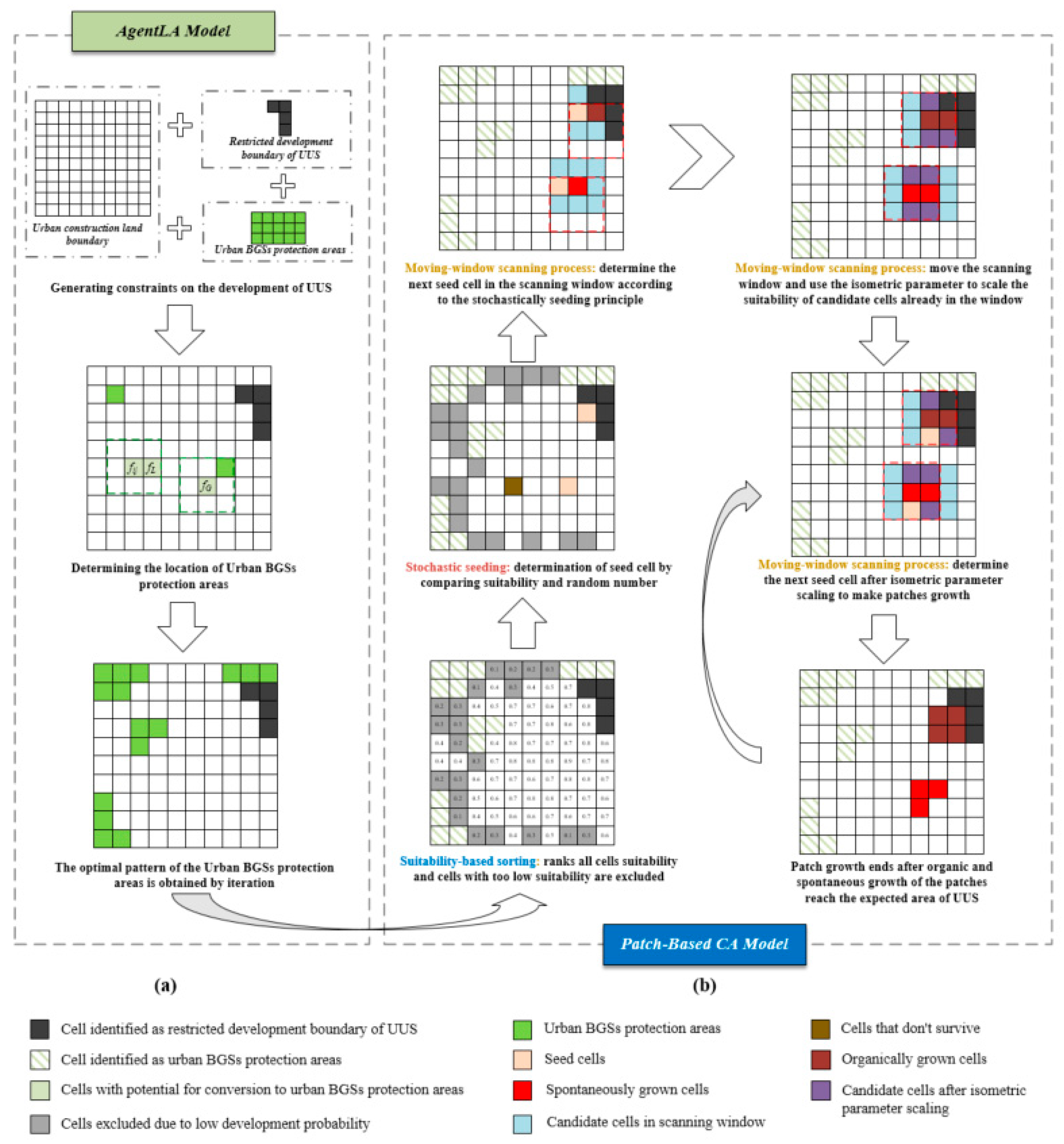
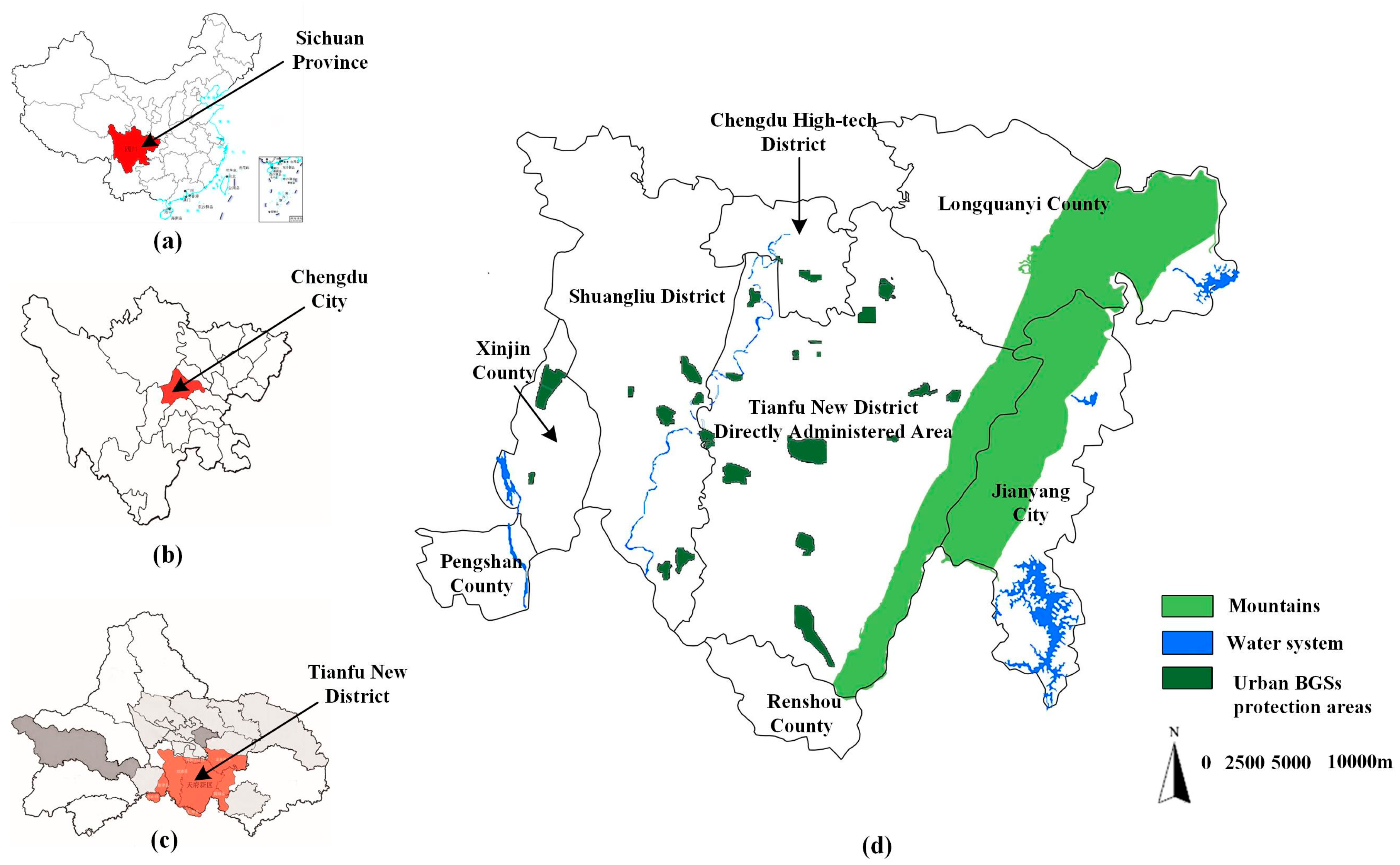
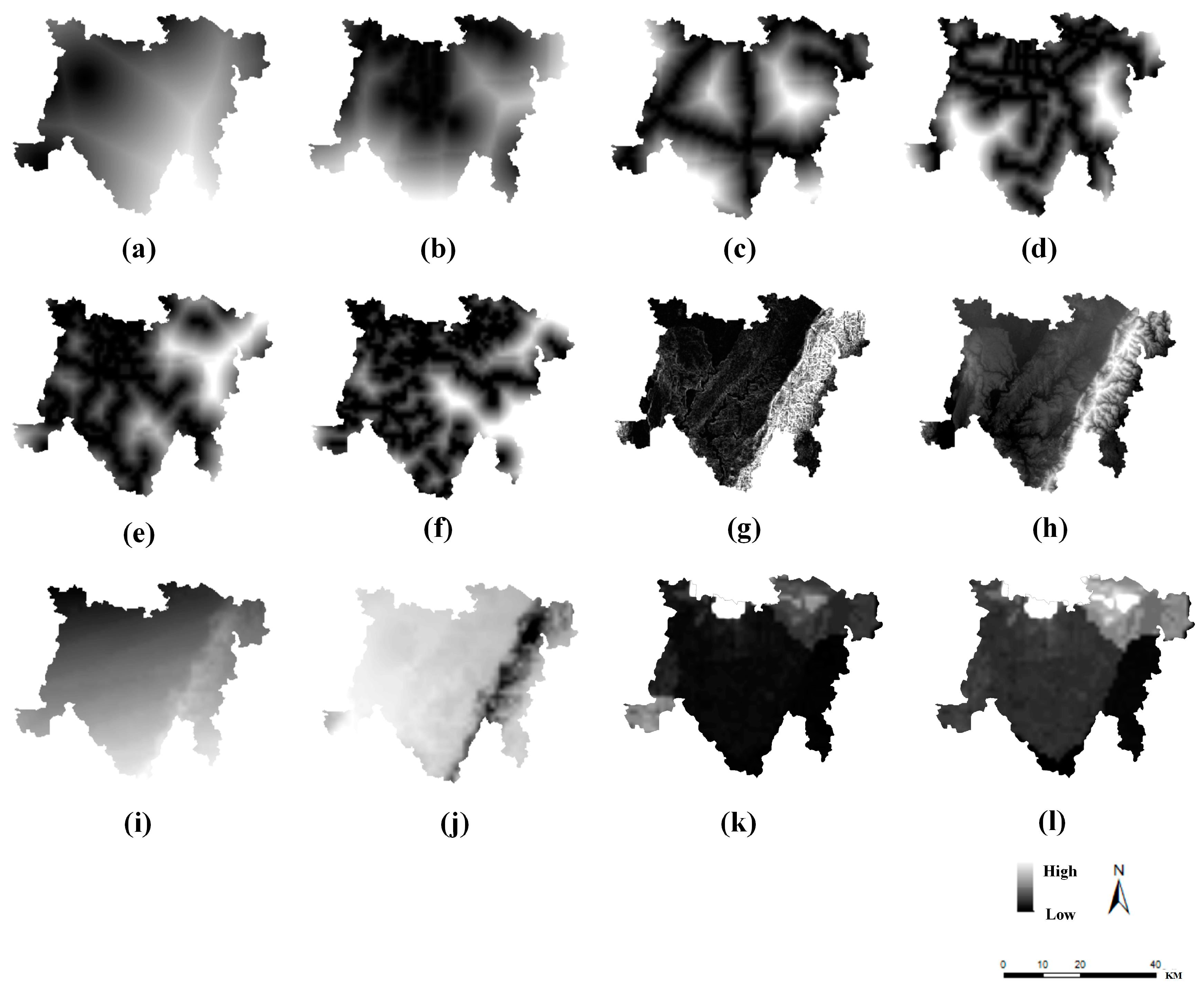
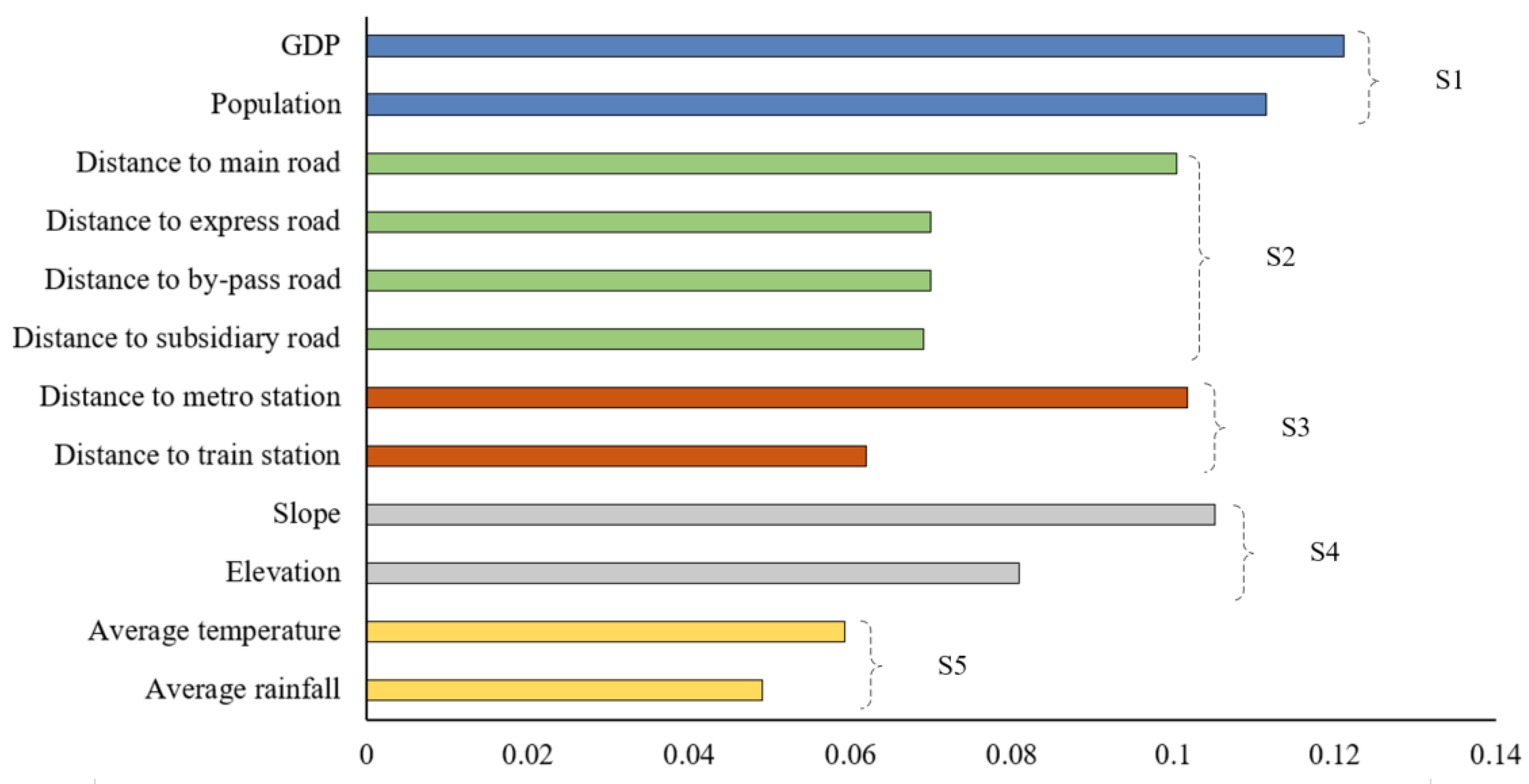
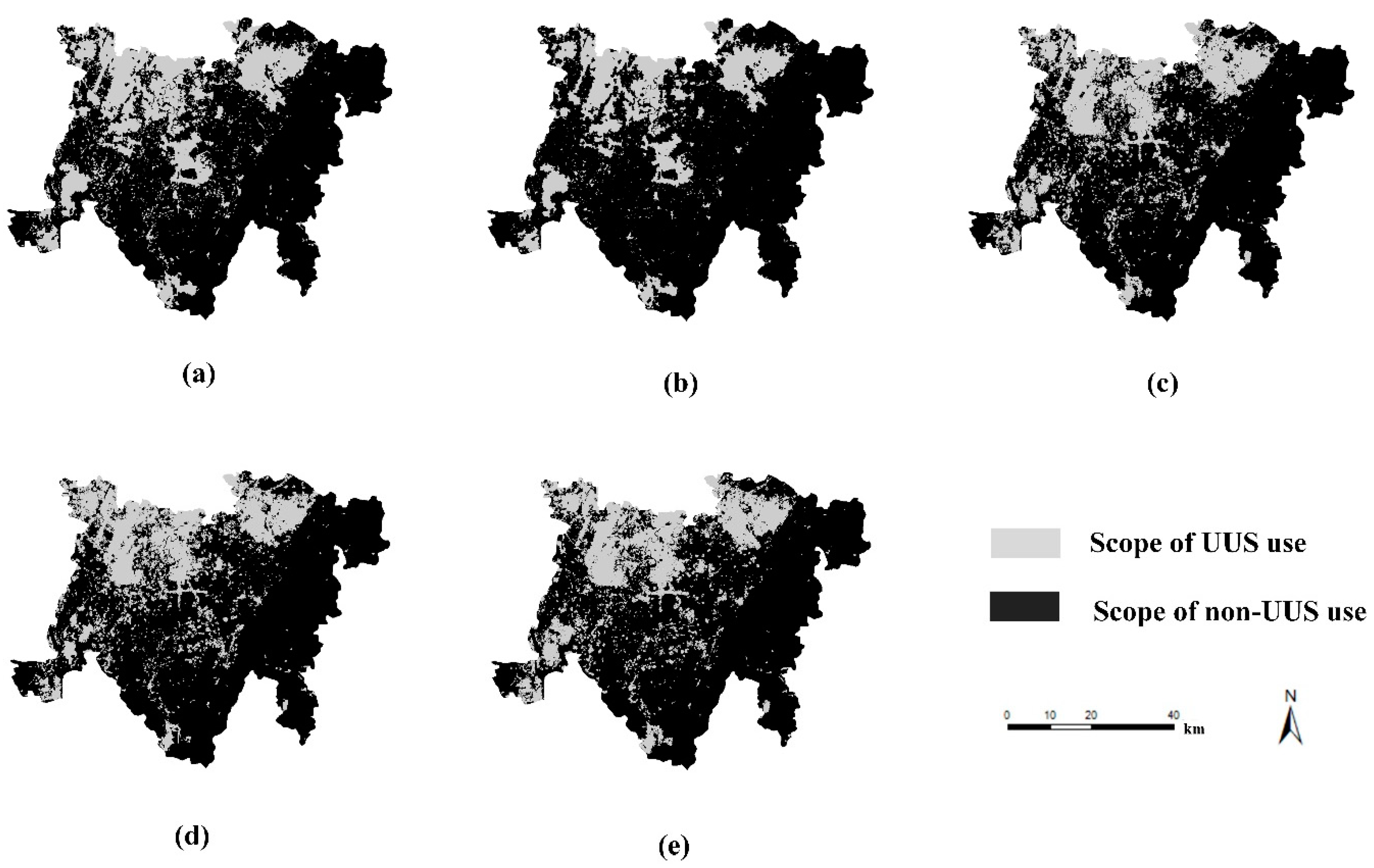
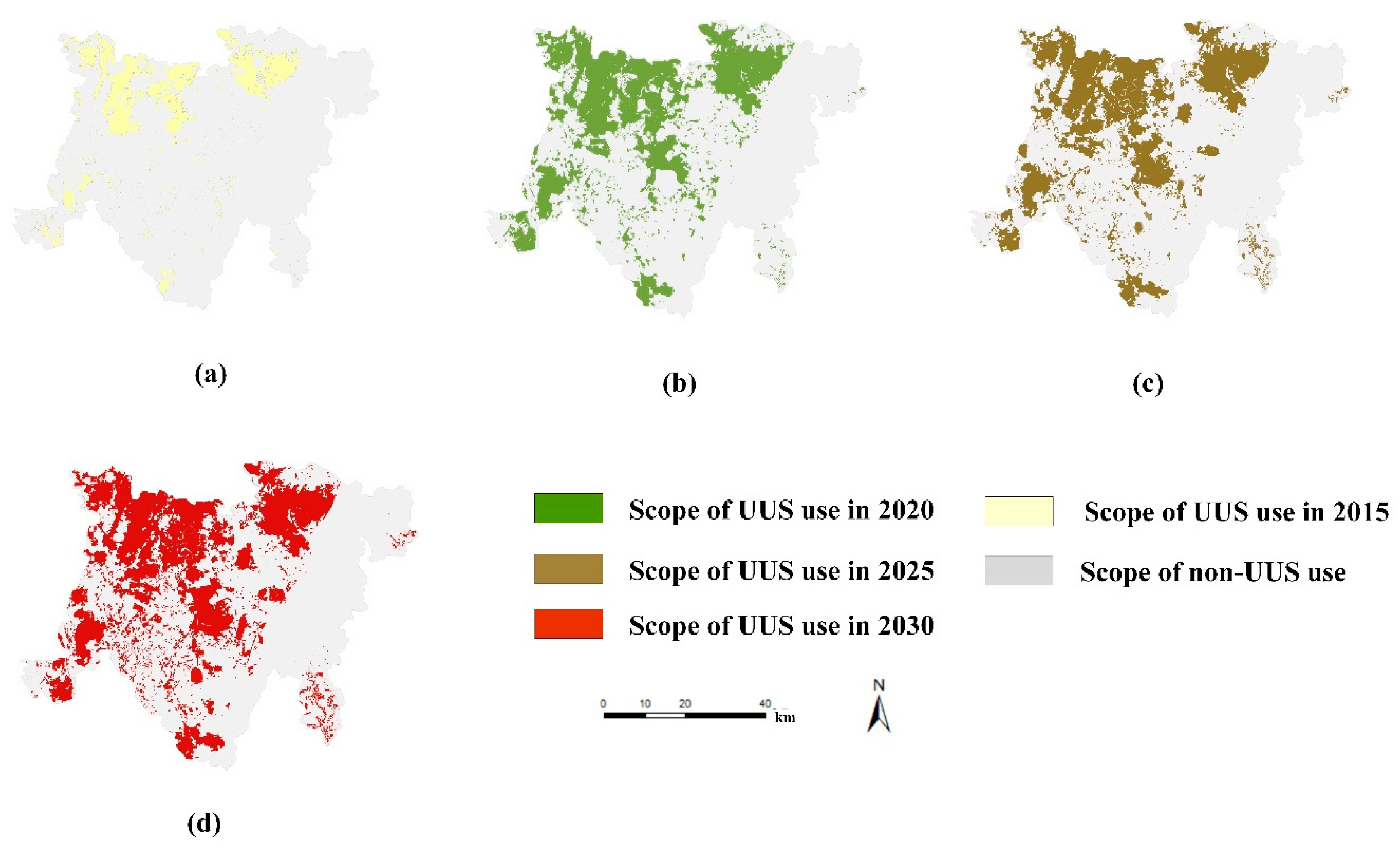
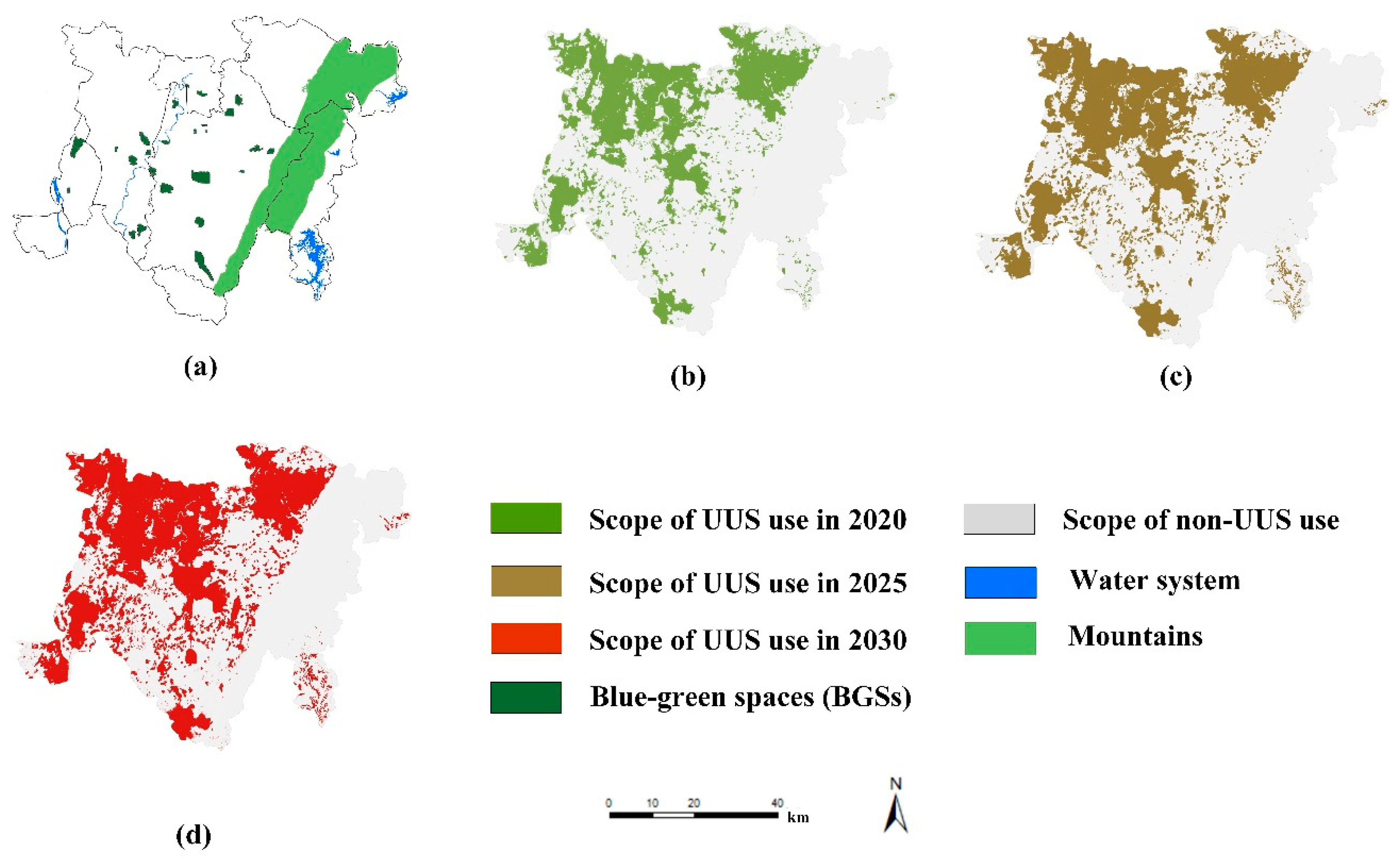

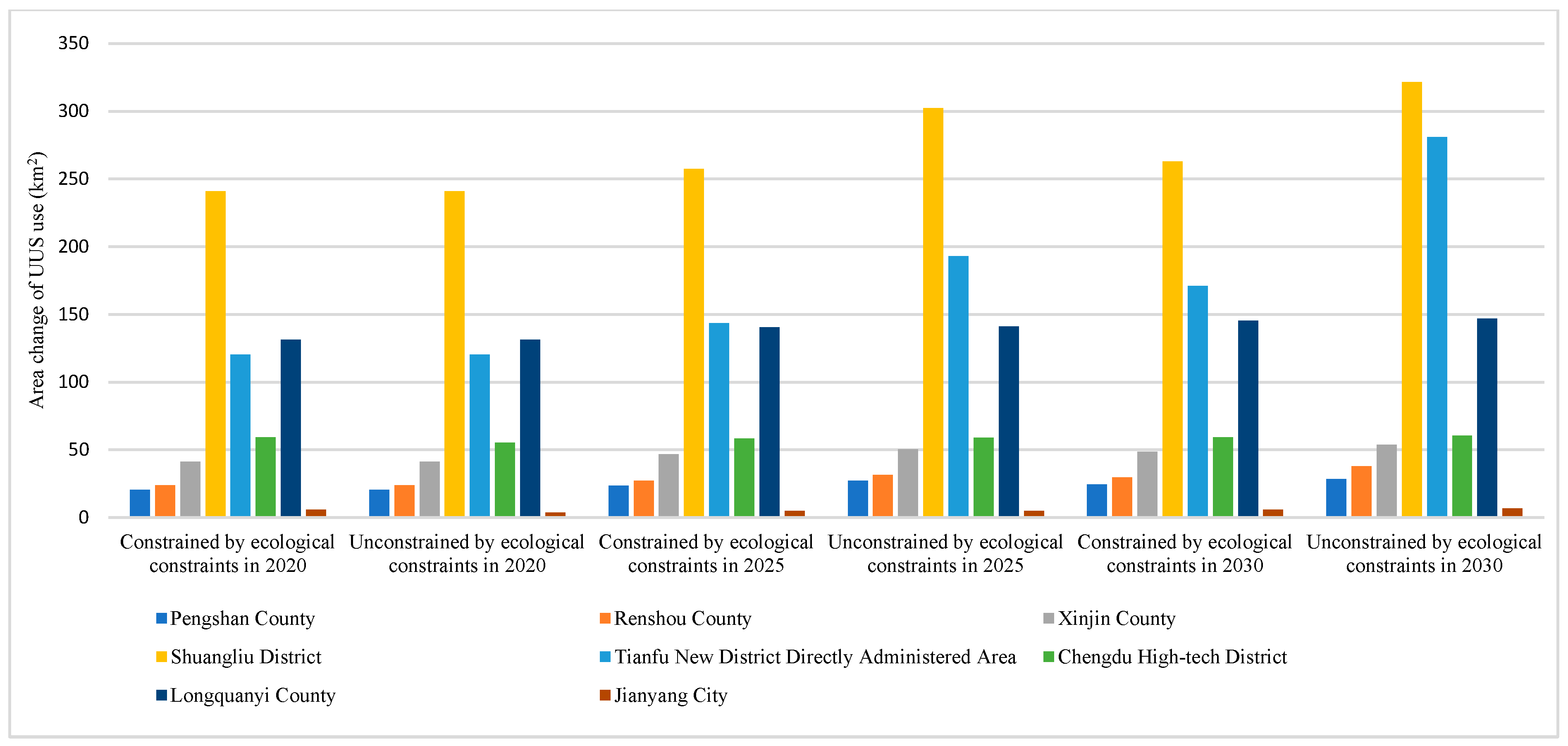
| Categories | Data Name | Data Source | Year | Spatial Resolution |
|---|---|---|---|---|
| Land use | Land-use data | Resource and Environment Science and Data Center in China | 2010–2020 | 300 m × 300 m |
| Topographical factors | Elevation | BIGEMAP Map Downloader | 2010–2020 | 100 m × 100 m |
| Slope | BIGEMAP Map Downloader | 2010 | 100 m × 100 m | |
| Socioeconomic factors | Population | Chengdu Statistical Yearbook 2021 | 2010–2020 | 1 km × 1 km |
| GDP | Chengdu Statistical Yearbook 2021 | 2010–2020 | 1 km × 1 km | |
| Traffic network factors | Distance to express road | OpenStreetMap (OSM) | 2010–2020 | 300 m × 300 m |
| Distance to main road | OpenStreetMap (OSM) | 2010–2020 | 300 m × 300 m | |
| Distance to subsidiary road | OpenStreetMap (OSM) | 2010–2020 | 300 m × 300 m | |
| Distance to by-pass road | OpenStreetMap (OSM) | 2010–2020 | 300 m × 300 m | |
| Transportation infrastructure factors | Distance to metro station | OpenStreetMap (OSM) | 2010–2020 | 300 m × 300 m |
| Distance to train station | OpenStreetMap (OSM) | 2010–2020 | 300 m × 300 m | |
| Constraint data of UUS development | Urban construction land boundary | Master Plan of Sichuan Tianfu New District (2010–2030) | 2010–2030 | Vector polygons |
| Mountains and water systems | Master Plan of Sichuan Tianfu New District (2010–2030) | 2010–2030 | Vector polygons | |
| Urban BGS protection areas | Master Plan of Sichuan Tianfu New District (2010–2030), Field survey and map street view | 2010–2030 | Vector polygons | |
| Climate factors | Average temperature | Geographic Remote Sensing Ecological Network | 2010–2020 | 100 m × 100 m |
| Average rainfall |
| Validation of Model Accuracy | The Model Constructed in This Study | RF-Patch-CA (Unconstrained) | ANN-CA | Logistic-CA |
|---|---|---|---|---|
| OA | 0.9042 | 0.7647 | 0.7743 | 0.7658 |
| Kappa coefficient | 0.7424 | 0.6150 | 0.6303 | 0.6161 |
| FoM | 0.3384 | 0.1164 | 0.1060 | 0.1178 |
| Name of Area | Area Change in UUS Use (km2) | Unconstrained by Ecological Constraints of Area Change in UUS Use (km2) | ||
|---|---|---|---|---|
| 2010–2015 | 2015–2020 | 2020–2025 | 2025–2030 | |
| Pengshan County | 6.6132 | 9.6533 | 6.7464 | 1.3467 |
| Renshou County | 8.2665 | 14.0530 | 7.4398 | 6.6132 |
| Xinjin County | 19.8395 | 19.0128 | 9.0931 | 3.3066 |
| Shuangliu District | 86.3844 | 83.3909 | 61.4105 | 19.2829 |
| Tianfu New District Directly Administered Area | 16.9462 | 67.9414 | 72.6906 | 87.9161 |
| Chengdu High-tech District | 18.1862 | 20.4799 | 3.7994 | 1.4447 |
| Longquanyi County | 41.3323 | 26.4526 | 9.5714 | 5.8122 |
| Jianyang City | 1.6533 | 1.3467 | 1.1599 | 1.8796 |
| Name of Area | Area Change in UUS Use (km2) | Constrained by Ecological Constraints of Area Change in UUS Use (km2) | ||
|---|---|---|---|---|
| 2010–2015 | 2015–2020 | 2020–2025 | 2025–2030 | |
| Pengshan County | 6.6132 | 9.6533 | 3.2665 | 0.7533 |
| Renshou County | 8.2665 | 14.0530 | 3.0931 | 2.6934 |
| Xinjin County | 19.8395 | 19.0128 | 5.3066 | 1.9197 |
| Shuangliu District | 86.3844 | 83.3909 | 16.4708 | 5.6101 |
| Tianfu New District Directly Administered Area | 16.9462 | 67.9414 | 23.2354 | 27.2920 |
| Chengdu High-tech District | 18.1862 | 20.4799 | 3.1332 | 1.0128 |
| Longquanyi County | 41.3323 | 26.4526 | 9.0931 | 4.7994 |
| Jianyang City | 1.6533 | 1.3467 | 0.9599 | 1.0796 |
Disclaimer/Publisher’s Note: The statements, opinions and data contained in all publications are solely those of the individual author(s) and contributor(s) and not of MDPI and/or the editor(s). MDPI and/or the editor(s) disclaim responsibility for any injury to people or property resulting from any ideas, methods, instructions or products referred to in the content. |
© 2023 by the authors. Licensee MDPI, Basel, Switzerland. This article is an open access article distributed under the terms and conditions of the Creative Commons Attribution (CC BY) license (https://creativecommons.org/licenses/by/4.0/).
Share and Cite
Wei, L.; Guo, D.; Chen, Z.; Hu, Y.; Wu, Y.; Ji, J. Growth Simulations of Urban Underground Space with Ecological Constraints Using a Patch-Based Cellular Automaton. ISPRS Int. J. Geo-Inf. 2023, 12, 387. https://doi.org/10.3390/ijgi12100387
Wei L, Guo D, Chen Z, Hu Y, Wu Y, Ji J. Growth Simulations of Urban Underground Space with Ecological Constraints Using a Patch-Based Cellular Automaton. ISPRS International Journal of Geo-Information. 2023; 12(10):387. https://doi.org/10.3390/ijgi12100387
Chicago/Turabian StyleWei, Lingxiang, Dongjun Guo, Zhilong Chen, Yingying Hu, Yanhua Wu, and Junyuan Ji. 2023. "Growth Simulations of Urban Underground Space with Ecological Constraints Using a Patch-Based Cellular Automaton" ISPRS International Journal of Geo-Information 12, no. 10: 387. https://doi.org/10.3390/ijgi12100387
APA StyleWei, L., Guo, D., Chen, Z., Hu, Y., Wu, Y., & Ji, J. (2023). Growth Simulations of Urban Underground Space with Ecological Constraints Using a Patch-Based Cellular Automaton. ISPRS International Journal of Geo-Information, 12(10), 387. https://doi.org/10.3390/ijgi12100387






